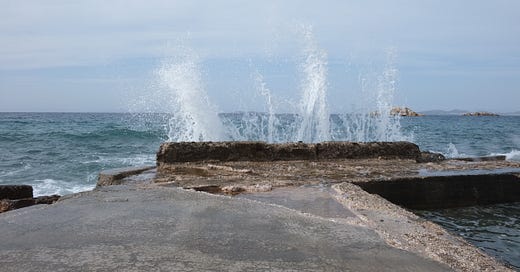A post inspired by Francesca Young Kauffman’s post Connections:
“academia remains (not always but too often) a place in which our wide-ranging interests and inspired asides are forced to narrow down and nestle into a safe little box.”
💯💯💯
Not only that, eventually some colleagues get to a stage in their careers where, having jumped through all those narrow hoops, they start to write differently. If you try to do this at an early stage of career you are actively discouraged in subtle or not so subtle ways.
‘Don’t run before you can walk’ is an expression I have heard one too many times.
It is so hierarchical who can or can’t be creative in the academy, how to be creative, and when they are allowed to be.
And it is complete bullshit.
In 2016 my research team and I (on a multimodal ethnographic study called ‘the connectors study’ and perhaps why I’ve chose to riff off Francesca’s post called Connections) started planning an exhibition that would showcase the photographic work of the children in our study.
The exhibitions ran over the winter of 2017 and 2018 in London, Hyderabad and Athens. Accompanying the exhibition was a catalogue for which I wrote the introductory / explanatory text. I also wrote the explanatory text for the exhibitions panels - about 10 of them.
I think this is probably the second of two writing experiences that changed my writerly course forever (the first was blogging but I leave that for another time).
I had to write for a ‘general public’ audience. For strangers. For unknowns. First it was very hard. Who would these strangers be? What did they need to know in order to appreciate the children’s images and the study context they emerged from? What register of language should I write in? How can I possibly know how the words would land when I had no idea who would come to the exhibitions?
The exhibition catalogue gave me a chance to translate the study into everyday language and to open up our researcher cares and concerns, as well as those of the children we’d been getting to know, to others.
No more ‘in’ and exclusionary vocabulary. No more technical terms. No more arguments only half well explained because you are either ‘in the know’ or you are not.
I had to put myself in the position of the curious stranger encountering our study - and the 50 plus years of research literature and traditions it was drawing from - for the first time. I wanted this stranger to come into the exhibition space, to stay a while, to stop in their tracks, to think with the children’s images and with the processes that created them, and to leave with a small, tiny part of them changed.
I had to write holding an unknown reader in mind, something I don’t think I ever did with technical academic writing. It’s a bitter sweet ‘in’ joke to say ‘nobody reads’ the academic articles we are increasingly required by national audit exercises to churn out (and at 4* no less!) Shifting from writing for ‘nobody’ to a ‘somebody’ was taxing and humbling. I loved the challenge and ran with it.
Writing in this way was incredibly freeing and totally corruptive. The narrow box of academic technical writing was blown out of the water.
‘I’m never writing another academic article!’, I confided to a friend. ‘I just want to write exhibition catalogues from now on!’
Writing in this way also gave me the opportunity to write with images as the key subjects. I wrote around the images. The introductory text was actually positioned in the middle of the exhibition booklet so that readers had to encounter and engage with the children’s images first before being given the context of the study and the questions we were attempting to address.
I was thrilled and I was hooked. The genie was out of her bottle. For good.
I have, of course, written academic articles since those words, but many include photographs and most are far more essayistic than they are technical writing - something ethnographic work lends itself well to but which not everyone who works ethnographically practices and not all editors and reviewers are amendable to. But I can no longer write in any other way.
The narrow box of technical academic writing feels like a violation, and my whole body says ‘no’.





I loved this piece, Melissa, really captured the way I feel I want to go with my writing (for both academic and public audiences).